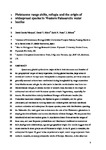Pleistocene range shifts, refugia and the origin of widespread species in Western Palaearctic water beetles.
| dc.contributor.author | García-Vázquez, D | |
| dc.contributor.author | Bilton, David | |
| dc.contributor.author | Foster, GN | |
| dc.contributor.author | Ribera, I | |
| dc.date.accessioned | 2017-06-22T12:52:19Z | |
| dc.date.available | 2017-06-22T12:52:19Z | |
| dc.date.issued | 2017-09 | |
| dc.identifier.issn | 1055-7903 | |
| dc.identifier.issn | 1095-9513 | |
| dc.identifier.uri | http://hdl.handle.net/10026.1/9515 | |
| dc.description.abstract |
Quaternary glacial cycles drove major shifts in both the extent and location of the geographical ranges of many organisms. During glacial maxima, large areas of central and northern Europe were inhospitable to temperate species, and these areas are generally assumed to have been recolonized during interglacials by range expansions from Mediterranean refugia. An alternative is that this recolonization was from non-Mediterranean refugia, in central Europe or western Asia, but data on the origin of widespread central and north European species remain fragmentary, especially for insects. We studied three widely distributed lineages of freshwater beetles (the Platambus maculatus complex, the Hydraena gracilis complex, and the genus Oreodytes), all restricted to running waters and including both narrowly distributed southern endemics and widespread European species, some with distributions spanning the Palearctic. Our main goal was to determine the role of the Pleistocene glaciations in shaping the diversification and current distribution of these lineages. We sequenced four mitochondrial and two nuclear genes in populations drawn from across the ranges of these taxa, and used Bayesian probabilities and Maximum Likelihood to reconstruct their phylogenetic relationships, age and geographical origin. Our results suggest that all extant species in these groups are of Pleistocene origin. In the H. gracilis complex, the widespread European H. gracilis has experienced a rapid, recent range expansion from northern Anatolia, to occupy almost the whole of Europe. However, in the other two groups widespread central and northern European taxa appear to originate from central Asia, rather than the Mediterranean. These widespread species of eastern origin typically have peripherally isolated forms in the southern Mediterranean peninsulas, which may be remnants of earlier expansion-diversification cycles or result from incipient isolation of populations during the most recent Holocene expansion. The accumulation of narrow endemics of such lineages in the Mediterranean may result from successive cycles of range expansion, with subsequent speciation (and local extinction in glaciated areas) through multiple Pleistocene climatic cycles. | |
| dc.format.extent | 122-136 | |
| dc.format.medium | Print-Electronic | |
| dc.language | en | |
| dc.language.iso | en | |
| dc.publisher | Elsevier BV | |
| dc.subject | Central Asia | |
| dc.subject | Dytiscidae | |
| dc.subject | Hydraenidae | |
| dc.subject | Mediterranean Peninsulas | |
| dc.subject | Quaternary glaciations | |
| dc.subject | glacial refugia | |
| dc.subject | range expansion | |
| dc.title | Pleistocene range shifts, refugia and the origin of widespread species in Western Palaearctic water beetles. | |
| dc.type | journal-article | |
| dc.type | Journal Article | |
| plymouth.author-url | https://www.ncbi.nlm.nih.gov/pubmed/28624516 | |
| plymouth.volume | 114 | |
| plymouth.publication-status | Published online | |
| plymouth.journal | Molecular Phylogenetics and Evolution | |
| dc.identifier.doi | 10.1016/j.ympev.2017.06.007 | |
| plymouth.organisational-group | /Plymouth | |
| plymouth.organisational-group | /Plymouth/Faculty of Science and Engineering | |
| plymouth.organisational-group | /Plymouth/Faculty of Science and Engineering/School of Biological and Marine Sciences | |
| plymouth.organisational-group | /Plymouth/REF 2021 Researchers by UoA | |
| plymouth.organisational-group | /Plymouth/REF 2021 Researchers by UoA/UoA07 Earth Systems and Environmental Sciences | |
| plymouth.organisational-group | /Plymouth/Research Groups | |
| plymouth.organisational-group | /Plymouth/Research Groups/Marine Institute | |
| plymouth.organisational-group | /Plymouth/Users by role | |
| plymouth.organisational-group | /Plymouth/Users by role/Academics | |
| dc.publisher.place | United States | |
| dcterms.dateAccepted | 2017-06-10 | |
| dc.rights.embargodate | 2018-6-15 | |
| dc.identifier.eissn | 1095-9513 | |
| dc.rights.embargoperiod | 48 months | |
| rioxxterms.versionofrecord | 10.1016/j.ympev.2017.06.007 | |
| rioxxterms.licenseref.uri | http://www.rioxx.net/licenses/under-embargo-all-rights-reserved | |
| rioxxterms.licenseref.startdate | 2017-09 | |
| rioxxterms.type | Journal Article/Review |


